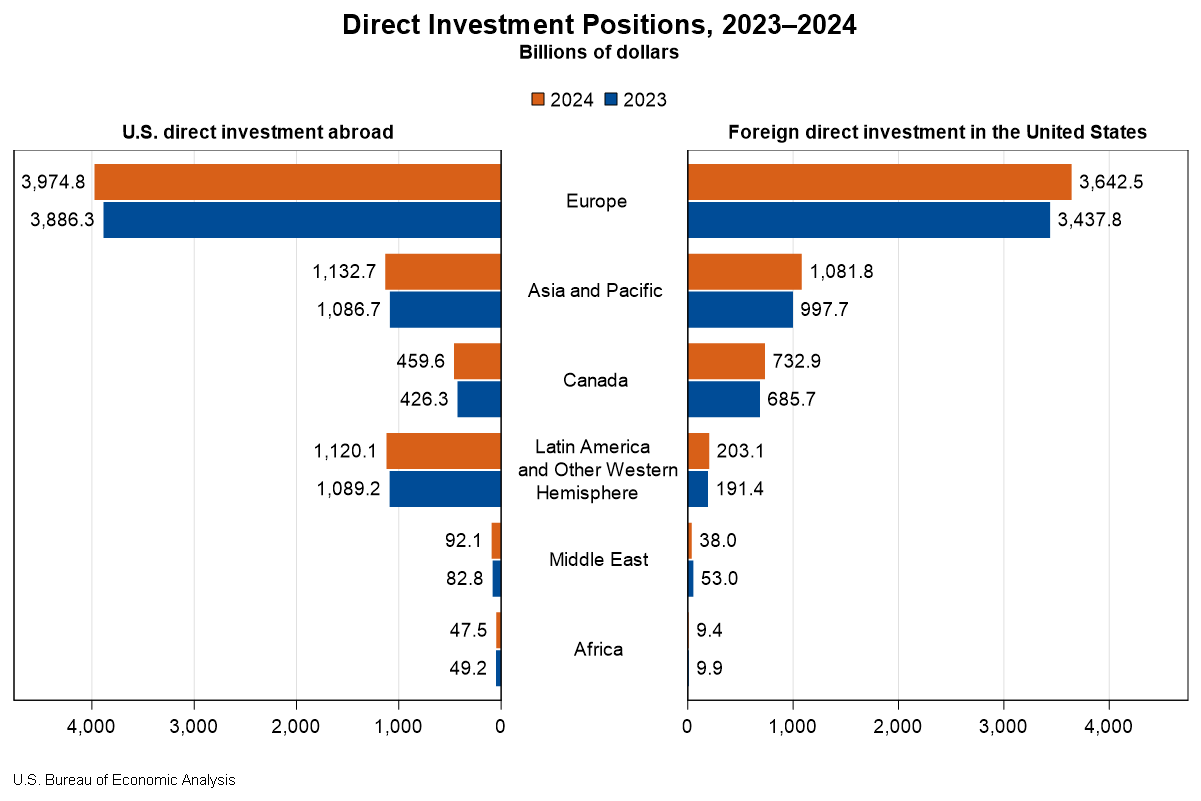Bureau of Economic Analysis
Direct Investment by Country and Industry, 2024
The U.S. direct investment abroad position, or cumulative level of investment, increased $206.3 billion to $6.83 trillion at the end of 2024, according to statistics released today by the U.S. Bureau of Economic Analysis. The increase was led by an $88.4 billion increase in the position in Europe, primarily in Luxembourg and Germany. By industry, manufacturing affiliates had the largest increase, led by manufacturing of computers and electronic products.
The foreign direct investment in the United States position increased $332.1 billion to $5.71 trillion at the end of 2024. The increase was led by a $204.7 billion increase in the position from Europe, which reflected a $52.9 billion increase from the United Kingdom and a $39.7 billion increase from Germany. By industry, affiliates in manufacturing increased the most.
Principal Federal Economic Indicators
Noteworthy
- 2025 News Release Schedule
- Innovation at BEA
- 2025 Annual Updates
- New! Services Trade Data for More Countries
- Data Tool: Trade in Value Added
- Distribution of State Personal Income
- Updated: RIMS II Regional Multipliers
- Arts and Culture
- Space Economy
- FDI Now in State BEARFACTS
- Quick Guide: Price Indexes
The Latest
U.S. International Trade in Goods and Services, April 2011; U.S. International Trade in Goods and Services, 2010 annual revision
Gross Domestic Product by State, 2010 (advance estimate) and 2007-2009 (revised estimate)
Personal Income and Outlays, April 2011
Personal income increased $46.1 billion, or 0.4 percent, and disposable personal income (DPI) increased $35.1 billion, or 0.3 percent, in April, according to the Bureau of Economic Analysis. Personal consumption expenditures (PCE) increased $41.5 billion, or 0.4 percent. In March, personal income increased $54.6 billion, or 0.4 percent, DPI increased $46.3 billion, or 0.4 percent, and PCE increased $54.8 billion, or 0.5 percent, based on…
Personal Income and Outlays, April 2011
Personal income increased $46.1 billion, or 0.4 percent, and disposable personal income (DPI) increased $35.1 billion, or 0.3 percent, inApril, according to the Bureau of Economic Analysis. Personal consumption expenditures (PCE) increased $41.5 billion, or 0.4 percent.
Gross Domestic Product, 1st quarter 2011 (second estimate); Corporate Profits, 1st quarter 2011 (preliminary estimate)
Real gross domestic product -- the output of goods and services produced by labor and property located in the United States -- increased at an annual rate of 1.8 percent in the first quarter of 2011, (that is, from the fourth quarter to the first quarter), according to the "second" estimate released by the Bureau of Economic Analysis. In the fourth quarter, real GDP increased 3.1 percent. The GDP estimates released today are based on more…
U.S. International Trade in Goods and Services, March 2011
U.S. Census Bureau: U.S. Bureau of Economic Analysis: NEWS U.S. Department of Commerce * Washington, DC 20230 U.S. INTERNATIONAL TRADE IN GOODS AND SERVICES March 2011 Goods and Services The U.S. Census Bureau and the U.S.
Personal Income and Outlays, March 2011
Personal income increased $67.0 billion, or 0.5 percent, and disposable personal income (DPI) increased $64.4 billion, or 0.6 percent, inMarch, according to the Bureau of Economic Analysis. Personal consumption expenditures (PCE) increased $60.7 billion, or 0.6 percent.
Gross Domestic Product, 1st quarter 2011 (advance estimate)
Real gross domestic product -- the output of goods and services produced by labor and property located in the United States -- increased at an annual rate of 1.8 percent in the first quarter of 2011 (that is, from the fourth quarter to the first quarter) according to the "advance" estimate released by the Bureau of Economic Analysis.
Advance Gross Domestic Product by Industry, 2010
Advance GDP by Industry Statistics for 2010
Durable-goods manufacturing and retail trade were among the leading contributors to the upturn in U.S. economic growth in 2010, according to preliminary statistics on the breakout of real gross domestic product (GDP) by industry from the Bureau of Economic Analysis. The economic recovery was widespread: 20 of 22 industry groups contributed to real GDP growth.




